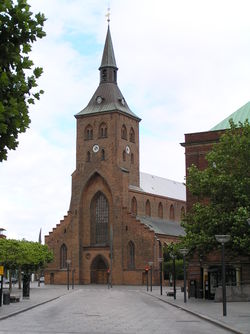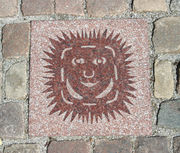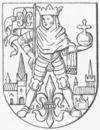Odense
| Odense | |||
|---|---|---|---|
 |
|||
|
|||
 Odense
|
|||
| Coordinates: | |||
| Country | |||
| Region | Region Syddanmark | ||
| Municipality | Odense Municipality | ||
| Established | 988 | ||
| City charter | 1355 | ||
| Municipality | 1970 | ||
| Area | |||
| - Total | 5.8 sq mi (15 km2) | ||
| Population (2010) | |||
| - Total | 166,305 | ||
| Time zone | CET (UTC+1) | ||
| - Summer (DST) | CEST (UTC+2) | ||
| Website | www.odense.dk | ||
The city of Odense (Danish pronunciation: [ˈoð̞ˀn̩sə]) is the third largest city in Denmark. The name Odense comes from the Norse god Odin.
Odense city has a population of 166,305 (as of January 1, 2010[update])[1] and is the main city of the island of Funen. It is the seat of Odense Municipality and was the seat of Odense County until 1970, and Funen County from 1970 until January 1, 2007 when the county became part of Region Syddanmark.
Contents |
History
- For the Catholic ecclesiastical history, see Roman Catholic bishopric of Odense
Odense (from Odins Vé, meaning "Odin's shrine", referring to the god Odin of Denmark's indigenous Norse mythology), is one of the oldest cities of Denmark and had its 1000th anniversary in 1988. To celebrate this, a forest named "the Thousand Year Forest" (Danish: Tusindårsskoven) was cultivated. The shrine of Saint Canute (Danish: Sankt Knud / Knud den Hellige) in Saint Canute's Cathedral held great attraction for pilgrims throughout the Middle Ages.
In the 16th century, the town was the meeting-place of several parliaments, and down to 1805 it was the seat of the provincial assembly of Funen.
Odense's most famous landmark was Odinstårnet (The Odin Tower) constructed in 1935, as the second-tallest tower in Europe, only surpassed by the Eiffel Tower. Odinstårnet was blown up by a Danish Nazi group in 1944 and has never been rebuilt. However, a miniature model of it now stands in the residential area Odinsparken in the area where the original tower was.
Until the beginning of the Danish industrial revolution, Odense was also the 2nd largest city in modern Denmark, but has in recent times been overtaken by Aarhus.
Famous residents of Odense
- Author and poet Hans Christian Andersen
- Classical composer Carl Nielsen was also born near Odense.
- King Canute IV, (ca. 1043 – July 17, 1086), also known as Canute the Saint and Canute the Holy
- Industrialist, banker and philanthropist Carl Frederik Tietgen
- Inventor and industrialist Thomas B. Thrige
- Handball player, Anja Andersen
- The cartoonist Henrik Rehr was born and grew up in Odense
- Her Royal Highness Birgitte, The Duchess of Gloucester was born and raised in Odense.
- Caroline Wozniacki, tennis player
- Peter Eastgate, winner of the Main Event at the 2008 World Series of Poker
- Musician Kim Larsen
- Industrialist Fredrick H. Johnson One of the American auto industry founders known as the Great Danes. Johnson invented the multiple process welding equipment that is still used today in assembly of autos. He was the father of Marilyn Johnson Smith and Fredrick H. Johnson.
- Painter, Lauritz Georg Christian Howe was born May 5, 1869 in Odense, the son of musician Joachim Ludvig Christian Howe and Anna Marie b. Larsen. Howe died August 1, 1945 in Copenhagen. Married in 1903 to Sophie Ingemann (1876-1949), daughter of teacher Frederick William Ingemann and Anna Elisabeth, three children.
Business



Several large industries are located in or near Odense. Denmark's largest shipyard, Odense Steel Shipyard owned by the A.P. Møller-Mærsk Group is in the neighbouring town Munkebo. The biggest sales auction of vegetables, fruits and flowers (GASA) in Denmark is situated here. The Albani Brewery brews the local Odense Pilsner amongst others.
The commercial national television company TV 2 is based in Odense.
In the south-eastern part of Odense the Rosengårdcentret shopping mall is located. The mall dates from 1971 and is one of the largest in Denmark with 100,000 m2 of commercially used area and 153 stores.[2]
Odense is the commercial hub of Funen, its retail businesses serve the surrounding cities. The city center houses a shopping district with diverse stores.
The city's central location in Denmark makes it one of the national convention and congress centers.
Education
The main campus of the University of Southern Denmark is located in Odense. A branch of University College Lillebaelt (Danish: University College Lillebælt) can also be found in Odense. Odense is home to 8 Gymnasiums, a business school, a vocational school, 21 public grade schools as well as a number of private schools.
Sports
Odense is the home of a number of football clubs. The most important are OB, FC FYN, B1909 and B1913.
The H.C. Andersen Marathon and Eventyrløbet is held annually in Odense.
Tourist attractions
Saint Canute's Cathedral (Danish: Sankt Knuds Kirke) was formerly connected with the great Benedictine monastery of the same name, and is one of the largest and finest buildings of its kind in Denmark. It is constructed of brick in a pure Gothic style. Originally dating from 1081–1093, it was rebuilt in the 13th century. Under the altar lies Canute (Danish: Knud), the patron saint of Denmark, who had planned to conquer England from William of Normandy. He was slain in an insurrection at Odense in 1086. Odense is also the see of the bishop of Funen. * The cathedral has the skeletons of both the Saint/King and his brother on public display, it also boasts of one of Denmark's finest altarpieces, a magnificent triptych by Claus Berg. A large fragment of Byzantine cloth is displayed next to the two skeletons.
Kings John (Danish: Hans) and Christian II are buried in the city.
Our Lady's Church, built in the 13th century and restored in 1851–1852 and again in 1864, contains a carved 16th century altarpiece by Claus Berg of Lübeck.
Odense Palace was erected by King Frederick IV, who died there in 1730.
There is a theatre as well as a symphony orchestra, a zoo, and the Funen Village (Den Fynske Landsby) which is an open air museum with old houses typical for Funen.
The City Hall has a small scar from a battle between Germans and members of the Danish Resistance on 5 May 1945. The city's coat of arms – located above the main entrance to City Hall – is damaged. On close inspection, the kneecap of Saint Canute is penetrated by a bullet.
The 4 most visited attractions in 2007 were:
1. Odense Zoo – 420,254 visitors
2. The Funen Village – 105,040 visitors
3. Danish Railway museum – 97,759 visitors
4. H.C. Andersen's House – 80,622 visitors[3]
Other attractions:
- Odense City Museums
- Hans Christian Andersen Museum
- Hans Christian Andersen's House
- The Funen Village
- Odense Theatre
- Odense Fjord
- Churches & Cathedrals
- Saint Knud's Cathedral
- Saint Albani Church
- Vor Frue Church
- Saint Hans Church
- Odense Zoo
- Odense Central Library
- Odense Sportspark
- University of Southern Denmark previously known as Odense University
- Odense Symphony Orchestra
- Odense Music School
- Danish Railway Museum
- Nonnebakken
Transport
The city lies close to Odense Fjord on the Odense River (Odense Å). A 7.5 metre (25 ft) deep canal, dug from 1796 to 1806,[4] gives access to the town's harbor from the fjord.
By road, Odense connects to Zealand and Jutland by way of the Funish Motorway (Fynske Motorvej), a section of the E20, and to Svendborg on the southern part of Funen by way of the Svendborg Motorway (Svendborgmotorvejen), which comprises the Danish route 9. Other, smaller routes connect Odense to the rest of Funen, with direct links to all coastal towns.
Odense's main railway station Odense station lies on the line between Copenhagen and Jutland, the peninsular mainland. International trains connect the town with Sweden and mainland Europe, and local and regional trains link Odense to the rest of Denmark. A separate passenger railway (Svendborgbanen) operates between Odense and Svendborg. Formerly, railways connected Odense to most of Funen's coastal cities, but these links were closed down in the 1950s and 1960s.[5] Today, these regional routes are served by buses operated by the public company FynBus, which also operates the town's municipal buses, connecting the town's suburbs to the city center.
Accessibility to Odense was greatly increased when the ferry service between the two main Danish islands, Zealand and Funen, was replaced by the Great Belt Bridge – opened in 1997 for rail traffic, 1998 for road traffic. When the bridge opened, it was the second longest suspension bridge in the world. Its construction greatly cut transportation time between Odense and the Danish capital, Copenhagen. Copenhagen can now be reached by trains from Odense in 1 hour and 15 minutes and Aarhus in 1 hour and 35 minutes.
Odense is served by Odense Airport, though the airport only operates regular flights during the summer months.
Population
The land area of Odense is 304 km2, with a population density of 611 per km2 (2005 figures from Helsingin Seudun Aluesarjat). The population of Odense city, per January 1 of a given year, according to Danmarks Statistik.
| Year | Population | Year | Population |
|---|---|---|---|
| 1976[6] | 138,348 | 1999 | 144,940 |
| 1981 | 136,646 | 2000 | 145,062 |
| 1986 | 137,286 | 2001 | 144,849 |
| 1989 | 138,339 | 2002 | 144,636 |
| 1990 | 138,986 | 2003 | 145,374 |
| 1992 | 140,886 | 2004 | 145,554 |
| 1994 | 143,029 | 2006[7] | 152,060 |
| 1996 | 144,518 | 2007 | 158,453 |
| 1997 | 145,354 | 2008 | 158,163 |
| 1998 | 145,296 | 2009 | 158,678 |
Twin cities
Klaksvík, Faroe Islands, and Sisimiut, Greenland
- For a full list of twin cities, see Odense Municipality
See also
- Odense municipality
- Odense Airport
- Roman Catholic bishopric of Odense
- Tourism in Denmark
- The Funen Village
References
- ↑ BEF44: Population 1st January, by urban areas database from Statistics Denmark
- ↑ Rosengårdcentret. "Om Rosengårdcentret – Rosengårdcentret" (in Danish). http://www.rosengaardcentret.dk/om. Retrieved 2 February 2010.
- ↑ Odense Municipality Statistisk 10 års oversigt 2008 -Tabel 40 [1]
- ↑ Thestrup, Poul; Dorrit Andersen, Niels Oxenvad (in Danish). Odense bys historie. Mod bedre tider. Odense 1789–1868. Odense Universitetsforlag. pp. 193–200.
- ↑ Danske Jernbaner (2008). "danskejernbaner.dk – Oversigt over danske jernbaner, stationer og deres historie" (in Danish). http://www.danskejernbaner.dk/. Retrieved 2 February 2010.
- ↑ Statistics Denmark tabel BEF4A 1976–2004
- ↑ Statistics Denmark tabel BEF44 2006–
External links
- Odense – City of Hans Christian Andersen
- The City of Odense
- FynBus – Municipal and regional bus operator
- Odense travel guide from Wikitravel
|
|||||||||||||||||
|
|||||||||||||||||||||||||||||||||||||||||||||||||||||||||||||||||||
|
|||||||||||||||||||||||||||||||||||||||||||||||||||||||||||||||||||||||||||||||||||||||||||||||||||||||
![]() This article incorporates text from a publication now in the public domain: Chisholm, Hugh, ed (1911). Encyclopædia Britannica (Eleventh ed.). Cambridge University Press.
This article incorporates text from a publication now in the public domain: Chisholm, Hugh, ed (1911). Encyclopædia Britannica (Eleventh ed.). Cambridge University Press.
